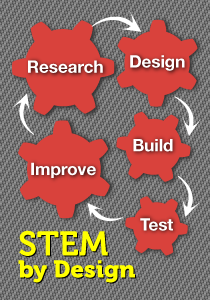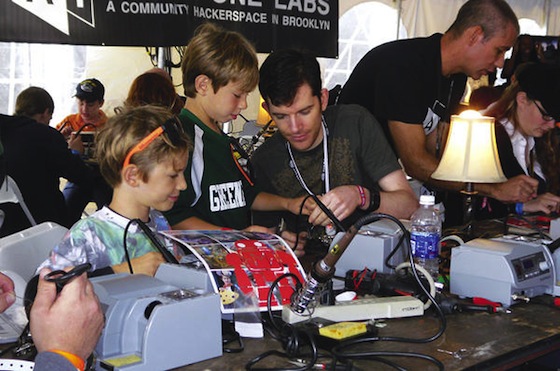10 STEM Tips to Share with Parents
A MiddleWeb Blog

Think about it: children are curious and constantly ask questions. They keenly observe the world around them and are good at connecting ideas. They sketch and draw a lot. They astutely observe others’ behaviors.
Children like to build models, break them down, and then begin again. They like to experiment and try new things. In a nutshell, children are great natural learners — just the kind of learners we need for successful STEM work (or any work, for that matter).
What happens to kids by the time they reach us in the middle grades? Among many of my 8th grade students, those valuable, innate thinking habits seemed to be hibernating.
I’ve often wondered how we might reignite our students’ curiosity and reset their previous habits of thinking. I certainly have no unique insights into this problem, but it seems to me that parents are an untapped resource. Who more than parents wants a child well-equipped for going into the world? Most parents have daily opportunities to interact with their children.
One study indicated that even modest involvement by parents can be a useful tool for boosting enrollment in STEM courses. So why not assume that parents can be helpful partners in leading children to reclaim their STEM-style thinking skills?
If you’re a teacher or school leader, consider making the effort to get your parents motivated and involved. Chances are you may have to give them information about STEM – what the acronym means and why STEM is important for their child’s future. Then give your parents some ideas for how they can help to prepare their children for success in STEM-style thinking. My parent STEM Idea List might look something like this:
10 Tips to Help Your Child Be a STEM Thinker
1. Be alert for opportunities to talk with your child about STEM-related topics. For example, talk about gravity when your child tosses a ball in the air. Discuss fractions or percent when you slice a pie. (Warning! Depending on the topic, you may need to do some brush-up research.)

3. View science and technology TV and videos with your child. Talk together about the program you viewed afterward.
4. Make your home a STEM-friendly place. Be enthusiastic about ideas that your child wants to test (within reason). Set up a place for experimenting and building prototypes. Provide materials for experiments. These don’t have to be expensive. Materials might include things like paper cups, craft sticks, glue, etc.
5. Organize groups of kids to participate in a STEM Invention Club. The Time to Invent website has all the information you need to guide kids in exploring and experimenting together.
6. Promote cooperation and teamwork as kids work together on STEM challenges. Before they begin working in teams, ask them to share behaviors they value in other team members. Guide them to develop a list of ground rules they will follow, based on their valued behaviors.
7. Search out STEM-related recreational activities such as a trip to a local science museum or a visit to an Exploreum. Visit robotics competitions or Maker Faires and encourage your child to ask questions and/or participate.
8. Stay in touch with your teacher and offer to help with STEM activities at school; or enlist help if needed with your STEM activities at home.
9. Direct your child to these websites for information and STEM fun:
- Design Squad – This PBS site features creative activities, engaging video, interactive games, and exciting contests.
- Discover Engineering – At this site children can view videos, play interactive games, and design “Cool Stuff.”
- National Geographic Education – This website features educational activities and videos, including some STEM activities.
10. Display curiosity about things you see and show your own interest in learning. This may be the most important tip of all. Your enthusiasm will be the greatest motivator for your child’s interest in STEM.
Your children can help change the world
At its heart, STEM is about solving real-world problems. The world is going to need more and more graduates with the skills to identify problems, visualize solutions, design prototypes and implement solutions. Your children could be among these graduates, helping changing the world for the better. Now there’s a goal that teachers and parents need to work together to achieve.
Photo: New York Maker Faire




































great idea – In Mustang OK we are just beginning a STEM focused course. I want to borrow and use your 10 STEM Tips for parents — can I find them in a pdf format? Or can I borrow and give you credit to use yours right off the blog.
So glad these are valuable to you, Gaile! Of course you can use these STEM Tips. You can use them right off the blog, and in return just point folks to MiddleWeb for more great information on STEM and other teaching ideas.
I will be using STEM this year in my sixth-grade math class. My principal ordered your 4-8 book for me. In the style of Yoda, “Excited I am!” Thank you, Anne Jolly, for sharing your expertise!
I’m delighted that you’ll be using the STEM by Design book! I think you’ll find it quite useful. You might also want to stop by the book website – http://www.stem-by-design.com. You’ll find lots of freebies there. Best of luck with your 6th graders.
I’m from Juneau STEM Coalition in Juneau, Alaska. We are preparing a STEM event for K-5 Families and are wanting to craft something similar to what you’ve written above. May we follow along with the actions of the others commenting and quote you liberally if we also give credit?
Hi Brenda. Glad you find the ideas useful. Please feel free to use them liberally and in any way you wish to make them helpful to your families.